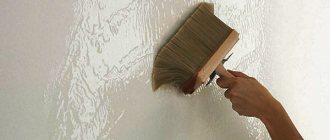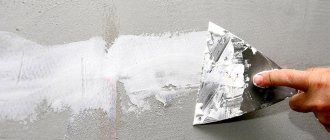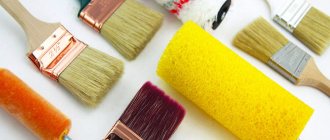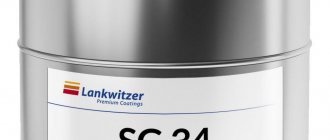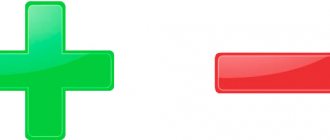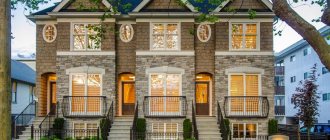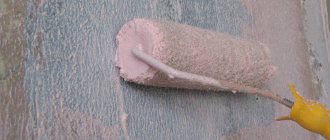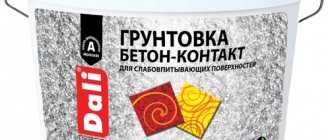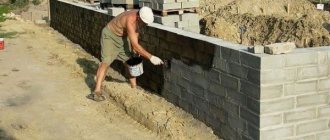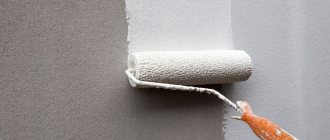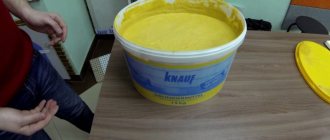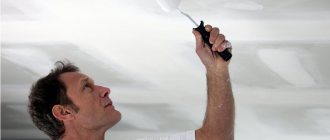MesterulManole
3519 0 0
MesterulManole June 27, 2017Specialization: many years of experience in finishing works of residential and office premises, dachas, country cottages, etc. Hobby: cycling in all its forms
Treatment of building surfaces with water repellents prevents capillary absorption of moisture
Most building surfaces do not tolerate excess indoor air humidity well. To prevent the destruction of walls and ceilings, a water-repellent primer (water repellent) is used. I will tell you about the current varieties of these products, and you can choose the appropriate composition.
Types of primers for the bathroom
Often, inexperienced people do not take into account the importance of preparing walls before laying tiles. As a result, the likelihood of poor-quality repairs increases.
To understand how to prime bathroom walls for finishing, let’s look at the existing types of primers for treating external and internal surfaces, which differ in various parameters - composition, method of application, level of protection from negative factors:
- Adhesive
This solution is used to improve the bond between the surface and the finishing material itself. Also, this primer for bathroom tiles has a number of functions:
- Reduced moisture absorption
- Providing strength to cracked surfaces
- Corrosion protection
- Acrylic
Suitable for protecting surfaces from harmful microorganisms. Bathroom primer is applied at the finishing stage, before the final finishing.
- Deep penetrating
The primer is intended for external and internal use, suitable for areas with strong adhesion. Its versatility lies in the fact that it can be used on walls before painting, plastering, or wallpapering.
- Insulating
This substance evens out the color of the final painting and allows you to maintain the saturation and brightness of the shade. Used for external and internal painted surfaces.
Waterproofing primer for wet areas
When constructing or overhauling premises exposed to moisture, it is necessary to consider high-quality waterproofing of structures. These include bathrooms, basements, loggias, saunas, as well as outdoor facilities. To prevent floors and walls from being destroyed by water, so that it does not leak to neighbors in the event of a flood, a water barrier is installed, an important element of which is a waterproofing primer.
Pickup from the warehouse is carried out from Monday to Friday from 8.30 to 16.45. How to order, pay and pick up goods:
Pre-order goods: be sure to place an order on the website or by phone with the note for pickup, no less than half an hour before the desired time of receiving the goods. Please wait for a call from our manager confirming the presence of the goods in the warehouse before visiting us.
Receive your order at the warehouse: At the moment, most of the products presented on our website are in a warehouse in close proximity to the office, but goods located in other warehouses in Minsk are available for sale. When pre-ordering a product, our specialist will tell you about the availability of the product and in which warehouse your order or part of it is located. When you pay for your order at the office, you will receive a directions and all the necessary explanations.
Payment: When ordering goods with the condition of pickup, payment for the goods is made only at the office of our online store! After payment, you receive a receipt and a copy of the receipt, as well as directions to the warehouse to receive the goods. You can pick up an order from the warehouse, paid for by bank transfer, only after you have issued a sales tax order (TTN) and signed all related documents in our office! The order can be shipped only after confirmation of receipt of money to the seller's account.
Types of primers with special performance properties
Not every material is suitable for bathroom renovations.
To choose a suitable soil mixture, you need to understand its properties.
Mixtures are divided into two types: strengthening and adhesion. When choosing them, it is better to contact a specialist. It will help you choose the right primer.
It is also worth paying attention to the finishing materials themselves.
primer for bathroom tiles is well suited to concrete walls Shellac and alkyd are used for wooden surfaces.
Waterproofing
Modern waterproofing allows you to protect surfaces and structures from moisture and water. Waterproofing materials help protect the roof, foundation, basement and bathroom. They come in various types. All materials differ in their purpose and place of application. Types of the best waterproofing materials
Waterproofing is divided according to the following parameters:
- by type of base material;
- according to the principle of action;
- by appointment;
- by appearance;
Features of the work
Let's consider the process of the preparatory stages of work. Let’s answer the question: “ Do I need to prime the walls before laying them ?”
Before starting priming:
- The plane must be cleaned of dust, dirt, and traces of old materials.
- It is necessary to follow the instructions on the packages of the mixture, stir only the specified proportions. Failure to follow the instructions will result in loss of properties of the mixture.
- The primer should be applied to the tiles using a roller; hard-to-reach areas can be treated with brushes.
Laying the slabs can only be done after the mixture has completely dried. Waiting times may differ from those indicated on packages due to temperature conditions or surface treatment.
Recommendations for selection
You should choose a primer based on the type of base and the composition of the soil itself. Surfaces that have special requirements for strength and reliability require a strengthening waterproofing primer. If we are talking about increasing the adhesive properties of the surface, then it comes down to adhesive primers.
The composition of the primer is of decisive importance. Indeed, depending on the composition, a moisture-proof primer can perform different functions:
- Alkyd primer has found its application for treating poorly absorbent and wooden walls. Its main feature is the anti-corrosion protection of substrates due to the presence of alkyd resin in its composition. Use for mineral and gypsum plasterboard surfaces is not recommended.
- Acrylic primer belongs to the universal category. Contains acrylic polymers. It can be used to treat any surfaces (gypsum plasterboard, hypo-fiber, concrete, cement, fiberglass, etc.). The only restrictions on use are metal bases. This primer combines the properties of both strengthening and adhesive compounds.
- Moisture-resistant mineral primer. The role of a binder can be played by cement, gypsum or lime. Used for impregnation of mineral bases - concrete, expanded clay concrete, brick, plastered, etc.
- Polystyrene waterproofing primer is intended for facade work. The same can be said about phenolic soil.
Moisture-proof primer for the bathroom, kitchen or other wet rooms is a unique composition that prevents moisture from penetrating into the thickness of the material, thereby minimizing the likelihood of destruction of the base due to constant humidity, which confirms the need to use primer.
Advantages of primer
All planes have invisible microcracks, which negatively affect the quality of adhesion and spoil the smoothness of the surface. The strengthening primer is capable of forming a flat surface onto which glue is applied.
Benefits of bathroom primer :
- Eliminating paint odor;
- Masking spots;
- Strengthening surfaces, giving a smooth appearance;
- Easy application of paint or glue;
- Preventing the development of mold and fungi.
Surface options
Many people choose ceramic tiles. But it is worth considering other materials.
- Painting
The advantages of painting are low cost and ease of finishing.
It is worth considering that not every paint is suitable for the bathroom:
- Acrylic, water-based - suitable for rooms with high humidity, have a low price;
- Silicone paints - have a complete moisture-repellent effect, are often used for painting facades, but are not suitable for bathrooms;
- Latex, water-emulsion - form an additional protective layer when drying, which repels moisture;
- Chlorinated rubber - differs from others in its durability, is much more expensive, and can be used in swimming pools.
Among the disadvantages, one can highlight increased requirements for surface preparation: after coating with paint, even minor defects will stand out.
- Wallpaper
The positive aspects of wallpapering in the bathroom include:
- A wide range of wallpapers, a predominance of different colors;
- Possibility of saving time and money;
- The ability to easily change the interior.
Disadvantages: not being a durable material, wallpaper is susceptible to mechanical damage. Even waterproof wallpaper is not suitable for placement in a shower stall or above a bathtub. Here it is better to use a different material.
- Drywall
Today, few people use drywall to decorate bathroom walls. However , it is an excellent option if the walls in the room are uneven. This finish will reduce the time and cost of leveling.
The benefits include:
- Low price;
- Easy to install due to its low weight;
- Increased heat/sound insulation indoors.
Only moisture-proof plasterboard is used in the bathroom; it has a green tint.
The downside is the need for further decoration of the surface, which makes repairs more expensive.
Procedure technology
Working with this type of concrete primer must be carried out strictly according to the rules.
You need to do some preliminary surface preparation first:
- Remove debris, dirt, and sand from the surface.
- Smoothing of large defects that stick out.
- The base is sanded and made smooth (to increase grip and reduce the consumption of the following materials).
- Large cracks and holes are covered with plaster.
- The entire base is wiped with a damp cloth and dust is removed.
- Cover the soil with an even and continuous layer.
The substance performs waterproofing functions after 12 hours.
Usually, such a composition can be added to the solution to improve the strength, but it is important to know that this is considered a violation of construction work, and therefore more than 4% of the total amount of the product cannot be used. The procedure should take place in a room where it is dry, well ventilated and not lower than +10°.
It is impossible for the waterproofing primer to freeze; if this happens, the mixture cannot be used, it must be thrown away.
Taking this into account, workers can defrost the substance indoors and use it during repair work. This is prohibited, because even if a hydrophobic coating is formed, it will last very little and will be of poor quality.
Choices for floors and walls
- Porcelain tiles
Ceramic tiles have always been popular. They are in the middle price category, have a wide range, and fit into any interior.
Porcelain stoneware is a ceramic slab with increased density.
- Vinyl coverings
Vinyl coating is intended for finishing the bathroom; it can be used in the shower and toilet. It has easy installation, good thermal conductivity, and heat resistance.
- Coatings made from different types of wood
Wood is also a good option. But we are not talking about ordinary parquet boards, but from special trees - rosewood, cedar, larch.
Humidity cannot damage modern wood materials that have been treated.
